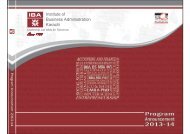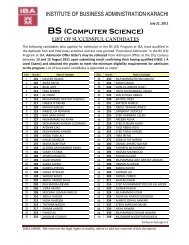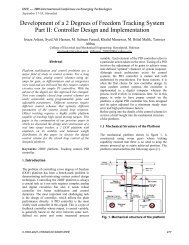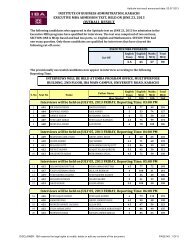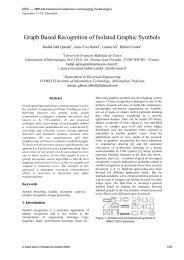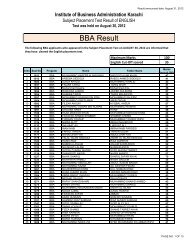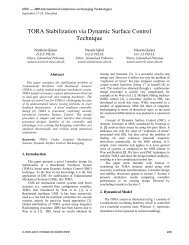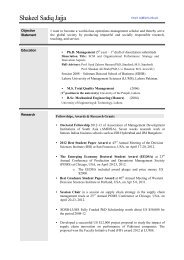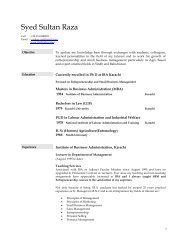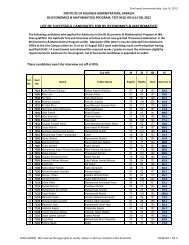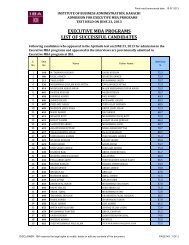Adnan Ahmed Khan, Sajid Bashir, Syed Ismail Shah
Adnan Ahmed Khan, Sajid Bashir, Syed Ismail Shah
Adnan Ahmed Khan, Sajid Bashir, Syed Ismail Shah
You also want an ePaper? Increase the reach of your titles
YUMPU automatically turns print PDFs into web optimized ePapers that Google loves.
IEEE --- 2005 International Conference on Emerging Technologies<br />
September 17-18, Islamabad<br />
the spreading gain, P(t) is the chip pulse shape that is<br />
assumed to be rectangular for our simulations and Tc is the<br />
chip duration.<br />
The channel introduces delays τ to signals from different<br />
users. The signals also undergo fading before they are<br />
summed up and received by the system receiver. The<br />
received signal r(t) can be written as.<br />
r( t)<br />
= ∑ Ak(<br />
t −τ ) Pk(<br />
t −τ<br />
) dk(<br />
t −τ<br />
) + n(<br />
t)<br />
) (2)<br />
Where A k , P k and d k are the delayed amplitude,<br />
signature code waveform and data signal of the k th user<br />
respectively, n(t)<br />
is the Additive White Gaussian Noise<br />
(AWGN).<br />
and partial cross-correlation values of the spreading<br />
sequences.<br />
Partial cross-correlation values among the spreading<br />
sequences are dependent upon how much one symbol<br />
overlaps with the other symbol, which in turn depends<br />
upon the transmission instants of the individual users<br />
(which is a random) instant and their distances from the<br />
base station (channel delays). Interfering portions of two<br />
symbols from each interfering user can be thought of as<br />
just one symbol. For example, in figure 2, portions of S 21<br />
and S 22 that interfere with S 12 can be regarded as a single<br />
interfering symbol. Thus, with random spreading<br />
sequences, the asynchronous and the synchronous systems<br />
will exhibit the same average bit error rate.<br />
S11 S12 S13<br />
S21 S22 S23<br />
Figure 2. MAI for two asynchronous users. Each<br />
symbol from a user is affected by two different symbols<br />
from the other users.<br />
Figure 1. CDMA generic Reverse link model,<br />
demonstrating a typical CDMA transmitter and a<br />
channel.<br />
The spreading sequence for all the mobile users when<br />
time aligned correlate with each other to give the symbol<br />
period correlation matrix.<br />
Rij(t) = ∫ Pi(t)Pj(t)<br />
(3)<br />
Rij(t) is the element of symbol period correlation matrix<br />
in the i th row and j th column obtained by taking the inner<br />
product of the PN sequence of the i th user with that of the<br />
j th user.<br />
3.2 Effects of partial Correlation of PN Codes<br />
At present the DS-CDMA systems employ Single User<br />
Match Filter (SUMF) detection. The detection is<br />
performed by correlating a locally generated replica of the<br />
spreading sequence of the user of interest with the<br />
incoming signal, as shown in Figure 3. The correlation is<br />
performed over a symbol period and it is assumed that the<br />
symbol-long portion of the locally generated spreading<br />
sequence correlates weakly with the spreading sequences<br />
of the other users.<br />
3. MAI Reasons Analysis<br />
3.1 Effects due to Asynchronous Link<br />
The reverse link of DS-CDMA behaves asynchronously<br />
as the received symbols from different users are not<br />
aligned to a single time base [13]. In an asynchronous<br />
system, one symbol of each user is contaminated by at<br />
most two symbols of the other users. So an N-user system,<br />
there will be (N−1) interfering symbols in the synchronous<br />
case and up to 2(N−1) interfering symbols in the<br />
asynchronous case. Figure 2 shows the interfering symbols<br />
in an asynchronous system with two users. It should be<br />
noted that an increase in the number of interfering symbols<br />
from (N−1) to 2(N−1) does not imply an increase in MAI<br />
in an asynchronous system compared with the synchronous<br />
system, because the cross-correlation products are<br />
computed only over the overlapping portion of the<br />
symbols. MAI and the bit error probability in this case are<br />
dependent upon relative magnitudes of the received signals<br />
Figure 3. SUMF Receiver. A typical CDMA uplink<br />
model with distinct single user matched filters for N<br />
users.<br />
For a particular symbol, the output of the SUMF is given<br />
as<br />
∫<br />
Yi (t) = r(t)P i(t)<br />
(4)<br />
symbol period<br />
Long PN sequences are based on the statistical quasiorthogonality.<br />
Since spreading segments are distinct for<br />
183



